Diane M. Simard's Blog, page 6
May 3, 2021
An Average Day in a Not-So-Ordinary Life
Wasteful humans that we are, Rene and I still receive the print edition of the Wall Street Journal Monday through Saturday. I refuse to let go of the smell and feel of inky newsprint in my hands as I dine on a lunchtime salad either at the office or take advantage of a rare opportunity to steal away to a restaurant for some solo sanity time.
Eight times a year, the Journal publishes a lifestyle magazine with its Saturday edition. Here is the magazine’s description from the Journal’s website:
“I always love and appreciate Diane’s wise perspectives and insights.” -Jim Holmes Keller Williams Realty
-Jim Holmes Keller Williams Realty 
“WSJ. Magazine is a luxury glossy news and lifestyle monthly magazine by the publishers of The Wall Street Journal.”
Interpretation: Forty pages of full-page color ads followed by a one-page teaser about the magazine’s three articles and two columns, followed by 20 more full-page ads, followed by a one-page article…and so on. The first 40 pages of ads are the creepy Salvador Dali-esque ads from clothing or jewelry designers like Chanel, Yves Saint Laurent, Tiffany, Gucci, Givenchy and Versace. You know the ads, where reedy models walk across desert sand wearing not much besides stiletto heels, or they wade barefoot in a faded plastic baby pool wearing a ball gown and diamonds. The surrealistic images twist innocent imaginations and curve tradition’s norms.
I briskly flip through the glossy periodical to ponder the images, pausing only to read a recurring feature that’s essentially a detailed inventory of a day in the life of someone significant, usually an escalating business icon. Important stuff like what time they woke up, what they did before breakfast, where they got their daily news, who they teleconferenced with and why, what apps are on their phone, who they lunched with, how much time they spent on email, how many business deals they negotiated and closed, and so on.
Mindless, boring mush. But I devour the 24-hour breakdown because I am intrigued by what effective, successful, impactful people accomplish in a day. Me, I stick to a rigid routine because the system works. Since I have always wanted to try it, I tracked everything I did on Friday, April 23, 2021. Here is a selection of the highlights. Hope you enjoy the mush…

4:44 a.m. Wake-up — it’s Fri-yay!
5:04 a.m. Fill my coffee cup with decaf and head downstairs to my office to check email. A company I invested in years ago, Bye Aerospace, is where I work as an Executive VP, plus I serve on the board of directors. Yesterday, the company announced plans to develop an 8-seat all-electric airplane called the eFlyer 800. Since I manage media relations, my email inbox is full again with questions from reporters and bloggers. My six-year-old laptop freezes up before I read through all the requests.
5:16 a.m. Hit reboot on my computer, then head to the exercise room to start a condensed yoga workout.
5:33 a.m. After finishing up with arm bands, sit back down to finish email responses.
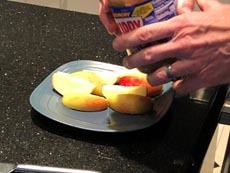
5:40 a.m. Get distracted by a Chico’s email about a cardigan and matching tank top sale. Color options are Kermit green, cheetah, moss green paisley and one that looks like remnants of a deconstructed pink pelican. Yikes! Pass.
6 a.m. Run upstairs for morning face cleansing, moisturizing and makeup routine. Ponder what to do with Day 5 hair while getting dressed.
6:20 a.m. Rene fixes me an apple and peanut butter for breakfast.
6:45 a.m. Go back down to my office to record a podcast with Helen Fospero, a delightful British journalist who connected with me to learn more about Bye Aerospace, then learned about my breast cancer experience and COPE, read The Unlikely Gift of Breast Cancer, and wanted to interview me for her Convex Conversations podcast that you can listen to here.
8:03 a.m. Helen and I finish recording, then I leave for the office.
11:25 a.m. Pack up and leave the office to work from home for the rest of the day while I try to remember why I needed to go to the office in the first place. Whatever the reason was, I completely forgot it.
11:55 a.m. Arrive home for lunch with Rene, then head back downstairs for an afternoon of Bye Aerospace remote work.

3:05 p.m. Walk on the treadmill for 20 minutes while I watch Season 2 of Stranger Things on Netflix. I’m not a sci-fan, but this show intrigues me by the way it captures early 1980s essence through hairstyles, clothes, language, music…even Tupperware containers and Corelle dishware in the kitchen scenes. Did every household besides ours in 1983 have a dark tan plastic Tupperware pitcher with a white top?
Speaking of Corelle, you can still purchase these dishes! I am proud to say I have eaten off plates with each of these patterns, and mom had both the light and dark blue patterns of Corelleware.
3:30 p.m. Ventureup to the kitchen to begin weekly food prep where I cook a couple meals, cut upfruits and veggies and decompress from a hectic week.
5:30 p.m. Dinnertime! Rene cracks his first beer of the weekend.


6:10 p.m. Bath and Sauvignon Blanc time. Ahhhh……
7:15 p.m. Watch the last episode from Ozark Season 1.
9:13 p.m. Lights out.
There. Extremely lame and not-at-all glamourous, but hopefully I did a bit of good in the world.
Feel-Good Moment
I shared in my January blog how Molly Rosado, a student athlete and junior clinical psych major at Robert Morris University near Pittsburgh, has decided to pursue a career in psycho-oncology. She was inspired to do so after learning about the Center for Oncology Psychology Excellence (COPE) specialty I founded at the University of Denver’s Graduate School of Professional Psychology five years ago. Molly is volunteering at the UPMC Hillman Cancer Center and recently donated 12 inches of her beautiful hair to the center.
Thank you, Molly, for sharing your inspiration and caring concern. Bright beacons of light like you recognize that some cancer survivors are unable to move forward until they are heard, understood and cognitively equipped for a new trajectory.
Update from One of COPE’s First Students
I received a delightful email this week from Dr. Hannah Katz, another bright beacon of light who was in the first cohort of COPE students and is now a clinical cancer psychologist. Here’s an excerpt:
“I wanted to take this time to first say thank you so much again for all you did to start COPE. The experience I gained through COPE allowed me to develop excellent skills and land my dream job! I am now a clinical assistant professor at the University of Kansas Medical Center and work as a cancer psychologist in the Hematological Malignancies and Cellular Therapies Division.”
Hannah then shared the great news that her hospital nominated her to be a Leukemia and Lymphoma Woman of the Year candidate — a philanthropic competition to support blood cancer research in communities across the country. The campaign is sponsored by the Leukemia and Lymphoma Society, which provides research, advocacy, and patient support for many of the patients Hannah directly serves in the Kansas City area. She asked me to pass along that she would be honored to have you join me in financially supporting her Woman of the Year campaign. More info here: https://pages.lls.org/mwoy/mid/kc21/hkatzo
And Now, Another Word from Our Sponsor
After responding to several requests for personalized coaching services, I added a link to my website for everything from help with self-publishing questions to self-promotion to career mentoring. If you know of anyone who might be interested, please point them to https://www.dianemsimard.com/coaching-services/.
Prayers
Before I go, please keep our dear friends, Jim and Judy Freshwater, and their son, Nick, in your thoughts and prayers. Jim is recuperating after having a brain tumor removed last week. Jim, Judy and Rene were in the logistics plans career field during their time in the Air Force, and Jim and Rene first worked together in 1992 at Ramstein Air Base in Germany. Thank you!
I close with these words:
We laugh,
We chat across the miles,
We worry,
We celebrate,
We ponder,
And we pray.
We lift each other up and offer support to those who need it more than we do today.
Just another average day in a not-so-ordinary life.

March 31, 2021
What’s the Deal with April 14?
This wandering soul, whose roots are deeply fortified in traditional journalism, rarely reads non-fiction. There are too many epic historical events that I find to be way more intriguing than made-up stories.
I particularly enjoy those “On this Day” TV newsclips and news columns. Take April 14, for example. The day songwriter Gillian Welch labeled “Ruination Day.” Here’s why:
A little after 10 p.m. in Washington, DC in 1865, actor John Wilkes Booth fatally shot then-President Abraham Lincoln.At 11:40 p.m. local time in 1912, the RMS Titanic hit an iceberg in the North Atlantic and sank two hours and 40 minutes later.In 1935, the “Black Sunday” dust storm blew over the lower plains states, displacing some 300 million tons of topsoil and turning a sunny afternoon into complete darkness.What’s my warped fascination with tragic events about? It’s not about death and mayhem. My heart breaks over the senseless loss of life, the injuries and the destruction of property. What I am most interested in are: 1) The causes of the tragedies; 2) What was done after the events to overcome the adversities; and 3) What was the psychological impact of the trauma-inducing events.

Resilience is a big deal to me. Yeah, I’ve had my share of challenges — the loss of family and other loved ones, financial losses from business investments, plus all my health stuff. But in reflection, every time there was a bump in the road, I was forced to learn something new. In a life that seems like it’s been full of potholes, I no longer remember the pain and suffering caused by the potholes, I remember what I learned. Something good eventually had to come from all the despair.
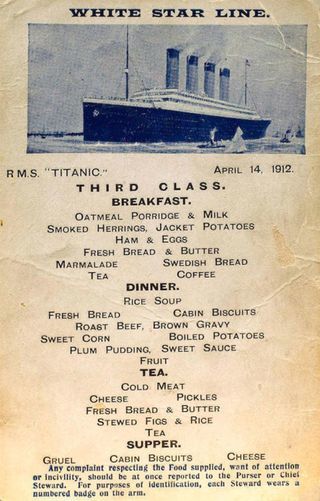
Here’s a recent classic. You might recall I took my last anti-cancer pill, Arimidex, in November, which prevented my body from producing estrogen, the hormone that “fed” the type of breast cancer I had six years ago. Although I was grateful for the opportunity to shut off what caused my cancer in the first place, life has genuinely gotten so much better now that I am off this potentially lifesaving drug. For starters, with some estrogen back in my tank, I now get to start metabolizing fat again for energy instead of having the fat cells sit there and accumulate. But since I’m still at high risk for heart disease (thanks Mom and Dad), I focus on eating a low-fat, low-carb, low-glycemic diet.
During my annual physical in January, my primary care doctor, Dr. G, was a tad freaked out because the triglyceride count in my blood had spiked. So, I told him I wanted to start tracking and baselining my diet, eating low glycemic fruits, lean proteins, and good carbs, and cutting way back on alcohol. Well, it worked. Results of my blood test in early March showed that my triglyceride count dropped by over 100 points, but my cholesterol had spiked. After observing my mini-meltdown, my hero, Rene, started reading labels and within 30 minutes solved the mystery.
It turns out that in January I switched from eating ground beef to eating ground turkey, thinking ground turkey is a leaner protein. Well yeah, MAYBE, but I was buying ground turkey, not ground turkey breast. And some ground turkey, like ground beef, can be off the charts in cholesterol if the fat count is significantly high. Guess who had been buying the wrong kind of ground turkey?
As Homer Simpson would say, “Doh!”
It was another learning moment, yet another opportunity to reinforce that I’m still a work in progress.
Before I close, did anything positive ever happen on April 14? Let’s see…in 1902, James Cash Penney opened his first store, Golden Rule, in Kemmerer, Wyo. Oh, never mind.
 Black Blizzard. Credits – Arthur Rothstein, The Library of Congress, Prints & Photographs Division.
Black Blizzard. Credits – Arthur Rothstein, The Library of Congress, Prints & Photographs Division. Here’s to making the most of every day. Even Ruination Day.

Cover photo: Dust Bowl – Dallas, South Dakota, 1936
March 3, 2021
Our Unconventionally Perfect Wedding Day

True love. A remarkable concept I assumed was a fantasy I would never experience.
Until Rene Joseph Simard.
Sound familiar? Are you thinking, “I’ve read that somewhere before?” Hopefully you have. Those two paragraphs are the opening reflections from my favorite chapter in The Unlikely Gift of Breast Cancer. Chapter 3, titled “The Situation is Well in Hand.” What my writing coach, Shari Caudron, called “the love chapter.”
10 Years
Yes, yes, Valentine’s Day was last month. But on March 13, 2021, Rene and I will celebrate our 10-year wedding anniversary. I deserve a significant amount of ribbing because I had never made it past five years of marriage, but as my brother, Lee, often reminds me, “You finally found a good one.”
I couldn’t agree more. Those of you who have met or have gotten to know Rene know he hates long meetings, he craves structure, and he loves craft beer and good Scotch. His experience in the Air Force taught him the benefits of discipline, tough but fair leadership, and accountability.
He is what many besides Lee have referred to as a “good guy.” Rene is good to me and good for me. He tolerates my incessant questions, the way I require him to not just give me an answer but to explain the basis for why he answered the question the way he did.
Grocery shopping for control freaks
Such as this classic dialogue. The scene takes place as we walk into the grocery store for our weekly shopping trip. I am very particular about the quality of our fresh produce, otherwise we’d have our groceries delivered. Since I hate grocery shopping, I attempt to make the experience as brief and efficient as possible.
Rene: “What can I go pick up for you?”
Me: “Well, please get a bag of whatever apples you like, then pick out something to grill from the meat department, then find a birthday card for your mother, and grab an 18-pack of eggs.”
Rene: “Okay, I’m gonna go look at cards first, then I’ll grab the other stuff.”
Me: “Why would you do that? The apples are right here in the produce department and the meat department is right around the corner. The way I laid it out for you is the shortest route.”
Now, in every memorable story there is a hero and a villain. Rene is the hero in this scene because he knows how to appease my control-freakiness. He picks out the apples and puts them in our cart, but then he goes to the card aisle, walking straight past the meat department. Not to rebel, but because he knows it’s way easier to read cards when he’s not juggling an armful of groceries. He completes his tasks out of order and pulls it off without me knowing he did it his way. The more logical way.
Yet more reasons why I love this man
Given my numerous failed attempts in the love department from age 16 to 40, I am so grateful I met Rene at middle age. We start and finish each other’s sentences, and I always enjoy his company. Thanks to 10 years of marriage and the sheer volume of Netflix entertainment we have consumed over the past 12 months, we have also finally learned how to watch television together. He catches things I miss when I’m daydreaming or dozing off to sleep, I hear things he can’t hear because of that whole guarding-B-52s-at-Loring Air Force Base-in-Maine-with-no-earplugs thing early in his Air Force career, and he no longer blurts out how he predicts shows will end. At the 60-minute bathroom break mark during movie night, we have learned to pause to compare notes and help each other understand what happened in the movie to that point.
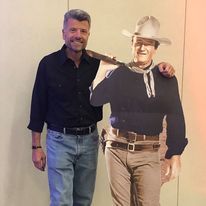
What I appreciate most about being married to “Marlboro Man” (sorry, ya gotta read the book to understand why I call him that) is he accepts me for who I am as I evolve, devouring information. That inquisitive trait is what keeps me functional. I can’t seem to stop wanting to learn more, stuffing my brain with knowledge/facts/Top 10 lists.

In a couple weeks Rene and I will celebrate a decade of marriage with a 2009 bottle of Dom Perignon friends gave us a couple years ago, then we will head to Sprague Lake at Rocky Mountain National Park, where we recited our vows in the wind-driven snowy forest that Sunday. Our wedding consisted of Rene, me, a minister, a photographer, the urn with Enzo’s (our beloved chocolate lab) ashes, and Mother Nature. Maybe we’ll make a pass through the drive-through at McDonald’s in Estes Park like we did after the limo driver dropped us off at our car after we were married. When the nice woman at the McDonald’s window handed us our order she screamed, “Oh my God did you just get married?”
Rene said, “Yep, and we didn’t have time to eat lunch, so we are starving.”
To which she replied, “So why are you eating here?”
Neither of us had an intelligent answer, so we looked at each other and laughed, then drove away. We live life unconventionally. On our terms. In true bliss.
Cool stuff happenin’This month I am so excited to introduce you to The Encourage Project, founded and fueled by one of my new favorite cool people, Amy A. Fairchild. If you are seeking positivity, optimism, and how to simplify the complex, please reach out to her. She and I dished for almost an hour last month on her podcast. Click here to listen, or search for The Encourage Project on Apple Podcasts.
And that’s a wrap!
Thank you, as always, for YOUR encouragement and support,


February 1, 2021
Mrs. Fernley and the “Cranberries” Incident
Fifty (cough-cough) years ago, I began walking two blocks every morning to kindergarten at Cotesfield, Nebraska’s School Dist. 14.
When I started my educational career in January 1971, my siblings and I were allowed one new pair of overboots per Nebraska winter, which lasted from September through May. Since my cheap rubber overboots tended to rip, every morning that first winter of kindergarten, after putting on my socks and blue Keds tennis shoes for kids, I slipped each foot into an empty plastic sack from a loaf of bread, then put on my red boots. Voila! Waterproofed and ready to face the day.

One Room. One Teacher. Seven Grades.
Cotesfield School Dist. 14 was a three-room version of Little House on the Prairie’s school, plus restrooms, a kitchen and a creepy furnace room that housed black metal music stands, a weathered bass drum and other antique band instruments from the early 1900s. Like Laura Ingalls-Wilder’s experience as a schoolgirl, our little school had one teacher for an average of 15 students among seven grades. There was likely a logical theory why kindergarteners in 1971 should start halfway through the schoolyear instead of in late August like the rest of the kids, and I recall it had something to do with the benefits of full-day versus half-day kindergarten. Either way, since both mom and dad had jobs and Grandma Moravec had babysat me since I was a baby, she had already taught me how to read and write the alphabet. As a result, my half-year of full-day kindergarten was a five-month non-challenge with milk, lunch and recess breaks thrown in.By far, my biggest obstacle in “kindy” was figuring out how to process the bizarre-ness of our teacher, Mrs. Nettie Fernley, a throwback to vaudeville who would guide my educational experience through first grade. With so few of us in the school sharing the same teacher, we all sat at our desks in the same room.
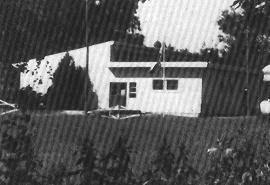
Mrs. Fernley seemed barely over four feet tall and was 75 years old when I started school, which means she was born in 1896. That’s not a typo. In 1896, Utah was admitted as the U.S.’s 45th state, Ford’s Quadricycle—the first Ford vehicle—was completed, and John Philip Sousa composed the Stars and Stripes Forever. She played piano for silent movies in the 1920s, so her style of piano playing was a cross between Dixieland, honky-tonk, and possessed Lilliputian. Imagine combing drum majorette moves with piano playing and that was Mrs. Fernley.
When it came time for us to sing, also known as music class, she’d sit down at the black antique upright piano with yellowing ivory keys and play Home on the Range in ragtime swing while we tried to keep up. Even after we ran out of verses to sing, she’d keep on playing. And playing. Her makeup was caked on and she wore bright-colored clothing, a black wig, stacks of fluorescent bangles on her wrists, dangly neon earrings and bright red lipstick. She also wore knee-highs instead of pantyhose, a visual one can never forget.
That Zaner-Bloser pen.
Although she was jolly and likable, Mrs. Fernley scared me because I could sniff her makeup and what smelled like stale Chanel N°5 perfume whenever she approached my desk. Since the special reams of writing paper with different sizes of lines had to be rationed over the entire school year, she would hand out individual sheets of paper for writing assignments, usually managing to leave a drop of drool on each sheet before handing it to a student. During rare moments of quiet time between classes she would twirl her dual-sided Zaner-Bloser pen with blue ink on one side and red ink on the other like a drummer twirling drumsticks while she sat at her desk to correct papers. When she wrote on the chalkboard in cursive, she would combine more drum majorette moves into her writing. Always performing.
 The big embarrassment for me in the Big K was an introduction to jellied cranberries for lunch, also known as dinner, which is what the noontime meal was called in Nebraska (the evening meal was supper). Anyway, the delicacy called jellied cranberries hadn’t been part of the Moravec/Faaborg household diet, so their open-heart-surgery red color apparently scared me one day at the noon meal because I began bawling uncontrollably once the school cook handed me my tray of food. I successfully avoided a straitjacket, thanks to an intervention from Grandma Moravec, who lived just across the street from the schoolhouse. In one of my report cards from kindergarten, Mrs. Fernley wrote this: “Has never cried since the ‘cranberries’ before Xmas.”
The big embarrassment for me in the Big K was an introduction to jellied cranberries for lunch, also known as dinner, which is what the noontime meal was called in Nebraska (the evening meal was supper). Anyway, the delicacy called jellied cranberries hadn’t been part of the Moravec/Faaborg household diet, so their open-heart-surgery red color apparently scared me one day at the noon meal because I began bawling uncontrollably once the school cook handed me my tray of food. I successfully avoided a straitjacket, thanks to an intervention from Grandma Moravec, who lived just across the street from the schoolhouse. In one of my report cards from kindergarten, Mrs. Fernley wrote this: “Has never cried since the ‘cranberries’ before Xmas.” 
Despite her eccentricities, Mrs. Fernley always cared deeply about others. My sister, Marilyn, remembers her letting her borrow books to read from the small library of books at her house, and she was always happy to entertain a crowd with her piano playing at church or school events.
A historic legend.
I recently learned that Mrs. Fernley’s first husband, Richard, fought in France with the “Rainbow Division” during World War I. The Rainbow Division was the brainchild of then-Army Major Douglas MacArthur, who would later become the infamous five-star general of World War II and the Korean War who smoked a corn cob pipe. He recommended taking National Guard units from across the United States and combining them into one division, the Rainbow Division, before deploying to France.
Unfortunately, Richard Fernley died from injuries he had sustained in the war soon after World War I ended. Mrs. Fernley later re-married, but continued to keep Fernley as her professional last name. She received her teaching certificate at age 14 from Nebraska State Normal School (now Peru State College—where Rene received his undergraduate degree!) and taught at numerous elementary schools in Nebraska, Wyoming, South Dakota, Kansas and Texas during her 69-year teaching career. In Nebraska, she taught at Ord St. Mary’s, Cotesfield, Hay Springs, Lakeside, Harrison, Hyannis and Humphrey St. Francis. When she was 37 years old, she had already been a schoolteacher for 23 years and was featured in 1933’s “Ripley’s Believe It or Not” as the youngest teacher in the United States with the most experience.
A Chicago Tribune article dated Nov. 12, 1989, mentions Mrs. Fernley in an article about Tombstone, an Old West tourist destination in Cochise County in southern Arizona, best known as the site of the Gunfight at the O.K. Corral. The article mentions “modern-day flashes of old-style charm.”
“At the Lucky Cuss, 93-year-old Nettie Fernley plays piano for tips collected in a goldfish bowl labeled ‘Music Kitty.’”
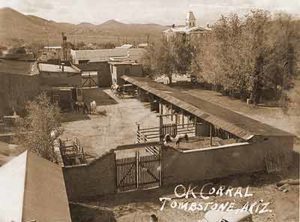
Mrs. Fernley passed away in April 1997 in Sierra Vista, Arizona, at the age of 101. She wasn’t necessarily my favorite teacher, but she was the first person I met who lived life on her terms—boldly and bravely—with just enough crazy thrown in to make her unforgettable.
She touched countless lives, and I am so grateful she is part of mine.
And now, a word from our sponsor.
Before I go, a couple updates:
Momentum continues to build around interest in psycho-oncology, which is the interdisciplinary field at the intersection of physical, psychological, social, and behavioral aspects of the cancer experience for patients, survivors and caregivers. Simply put, it’s a term I will now be using to describe my efforts to bring more resources, including training for caregivers, to those impacted by cancer. The physical scars from cancer may heal, but the psychological scars are deep, and in some cases, permanent.
Listen here for an approximately 20-minute podcast with Kelly Goering at Evolving Smart where I advocate for psycho-oncology and share an early-career story about my first brush with racism in the workplace:
Go to Podcast
If you know of anyone who might enjoy reading my blogs, please ask them to send me an e-mail or let them know they can sign up at DianeMSimard.com.
One final thought. I learned to love cranberries. The redder the better!
To all the unforgettable kindergarten teachers out there,

December 30, 2020
There’s Always Next Year
Well, we did it. We made it to the end of the year that made no sense. Are you giddy? Gloomy? Melancholy? Grateful? Frustrated? Outraged?
Me, I’m numb. Still sober-drunk, cranking out my annual new-year goals. They are not resolutions, which I refer to as “guaranteed fails.” No, every year I make goals for one, five and 10 years out.
Much to my disappointment, I accomplished only five of 11 goals for 2020. Ouch. Only one missed goal can be blamed on Covid-19: Meet in person with my state senator and representative. I will make it happen next year. My fellow survivors and I need our state legislators’ help to strategize policy changes to bring more individualized mental health support to those of us forever impacted by psychologically traumatizing illnesses. Which, besides, cancer, now includes Covid-19.
A personal note of thanks to my dear friend, state legislator, and all-around good guy, Rep. Mark Baisley, for continuing to support me in this effort.
There’s always next year. That’s not an excuse, but a commitment to continue moving forward, to keep pushing boulders up mountains.
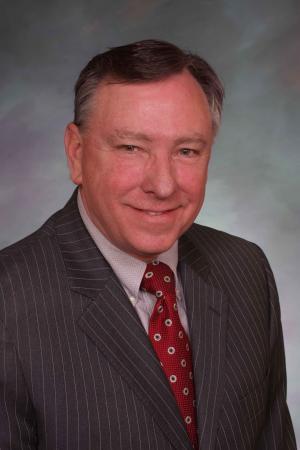
Our precious Enzo.
Time for some reminiscing. Ten years ago this holiday season, Rene and I were struggling with the sadness of the final days with our 12-year-old beloved chocolate Labrador Retriever, Enzo, who had been with me since he was six weeks old. But this year we are determined to remember him with smiles instead of tears. Perhaps it was because he was my only companion for many years that he came to have telepathic powers and the ability to read my mind. You’ve never seen an animal move so quickly as when I would say, “Should we go?”
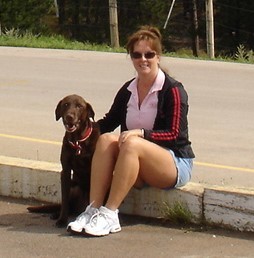
Enzo never wanted to be without his human companions. On four separate occasions, he attempted to jump into the back of my SUV before we opened the door. Thankfully, even though he slammed head-first into the tailgate, he was unfazed and unhurt. Every time we laughed while we marveled at his loyalty. He unequivocally did not want us to forget to bring him with us.
If life’s memories should ever fade from my mind, I hope those of Enzo never do. He was my protector during a lonely, dark time and will always be one of the greatest gifts I was ever blessed to receive.
Year-end reflections.
As is my year-end tradition, it’s time to pause and reflect on those who left us this year, to celebrate the friendship, laughter and joys they brought to my life. Special prayers of remembrance and comfort to the families of Tim Fitzsimmons, John Wroblewski, Paul Rosenberg, Sally Bishop, and Anna Jansen.
Then there’s the extensive list of public figures we lost who made me think, laugh, cry, and sing. Many of them influenced me to study, to practice, and to keep trying harder:
· Gayle Sayers – NFL football player great who co-wrote the book, I am Third, and on which the movie, Brian’s Song is based. In 2021, I will devote an entire post to the impact this movie has had on me.
· Bill Withers – singer/songwriter whose song, Lovely Day, is one of my standard lift-me-up songs.
· Fred “Curly” Neal – whenever the Harlem Globetrotters were on ABC’s Wide World of Sports on Saturday afternoons in the early 1970s, I was glued to the TV set, ignoring mom’s warnings to back up unless I wanted my eyeballs to explode. Curly Neal was a virtuoso ball-handler, and he hypnotized me with his ability to dribble while spinning on his knees. He was mesmerizing, hilarious entertainment.
· Helen Reddy – singer/songwriter who sang I am Woman, released in 1971. Even at the age of 6, I got goosebumps.
· Mac Davis – another 70s singer/songwriter. He wrote hit songs for singers from Elvis to Dolly to Reba to Kenny. That frizzy, perfect hair! He passed away the same day as Helen Reddy. Both were 78 years old.
· Supreme Court Justice Ruth Bader Ginsburg – two words. Perpetual awe.
· Neil Peart – the drummer and primary lyricist for the rock band, Rush. He was called “The Professor” because of his technical prowess and stamina during live performances. Like other musicians I respect, he said little and let his art do the talking.
· Many others who passed away in 2020 would each have a page in the scrapbook of my life: Alex Trebek, Sean Connery, David Lander (Squiggy from Laverne & Shirley), Eddie Van Halen, Chadwick Boseman, Little Richard, Congressman John Lewis, Regis Philbin, Kobe Bryant, Wilford Brimley, Jerry Stiller, Phyllis George, Fred Willard, Kirk Douglas, Kenny Rogers, Kelly Preston…and many others.
“Why We Fight.”
I will close with this. Near the end of the masterful HBO mini-series, Band of Brothers, one of the episodes is titled “Why We Fight.” Easy Company is called in when a patrol in a nearby forest discovers an abandoned Nazi concentration camp and the troops are a first-hand witness to the atrocities committed by the Nazis. As World War II starts to come to a close, the members of Easy Company begin to put their losses and traumatic war experiences into perspective, processing the evil, yet heroic, acts of war.
With that in mind, about a month ago, a delightful female college student-athlete reached out to me on LinkedIn with this message:
“Hi Mrs. Simard, my name is Molly Rosado and I am a student-athlete at Robert Morris University and a member of the Colonial Leadership Academy. This is an athletics program designed to develop leadership, professional, and life skills for student-athletes. The goal is to build as a person and transfer what we learn into life beyond college. One of our assignments this year is to have a conversation with someone in our intended career field. My plan is to become an oncology psychologist. I was particularly interested in reaching out to you as I know you are the founder of COPE at the University of Denver. I believe that out of all people, you are the person I could learn from the most. Not only did you battle cancer, you took your experience and transformed the world of oncology psychology. In the fall of 2019, I found a 14 centimeter mass on my ovary. I was getting tested for ovarian cancer at only 19 years old. Two days before Christmas, I received a phone call from my doctor and he gave me the best news I could’ve ever asked for… no cancer. Though I had a great outcome, the situation had an outstanding impact on me. A new passion formed for oncology psychology. I want to make a difference in the world, just like you. I am now a junior majoring in clinical psychology with a minor in sociology. After I earn my degree, I hope to attend your COPE program at the University of Denver. I truly admire all of your work and hope to learn from you.”
Molly and I met for the first time via video call a few weeks ago and talked for an hour and 45 minutes about our shared life’s calling. Her message is the embodiment of why I fight. Why I keep trying harder and remain committed to helping those traumatized by cancer.
May you continue to live your purpose, too.
To brighter days!

December 1, 2020
The Holly-Jolly Year of Me That Wasn’t
What a chaotically complicated, fascinating time to be alive. I keep hearing people say they are glad 2020 will finally be over soon. Are they convinced the clean canvas of a new year will erase the sober-drunk head-scratching state of a world full of people who can’t seem to tolerate OR survive without each other?
The holidays are here, the home stretch to our year-end countdown. Eleven months ago, I was in a mental state similar to early 2015, preparing to enjoy a year of ME.
Rene and I were planning to spend a lengthy, relaxing stretch of time with our friends and family in central Nebraska six months ago, attending the wedding of my oldest brother, Randy, to his amazing new wife, Bobbi, and her fabulous family who have been such a wonderful addition our family. My goal was to spend hours capturing stories and memories of small-town life and how those experiences laid the foundation for the me of today.
Unfortunately, Covid-19 and its devastating effects erupted in mid-March, followed soon by the realization that the responsible thing to do because of the leadership requirements for my job at Bye Aerospace was to not make the Nebraska trip. Instead, Rene and I sat down at the bar-height patio table on our deck late in the afternoon on May 30 to watch Randy and Bobbi’s wedding live from The Oasis, my other brother, Lee’s, place at Lake of the Woods, north of St. Paul.
As we watched members of the wedding party take their places via FaceTime feed thanks to my nephew, Eric, Rene accidentally tipped over his beer glass, and a beer wave headed straight for the iPad. I lunged and grabbed the iPad a second before the IPA tsunami hit, but fat-fingered “end” on the screen in the process, prompting an unusually long string of curse words. Rene picked up his glass and moved it next to the barbeque grill, then rushed into the kitchen to grab a towel to mop up the mess. When he was done, he set the half-full beer glass back on the patio table, only to accidentally tip it over again, spilling out the remaining contents.
At that point we burst into laughter at our clumsiness while I FaceTimed Eric on my phone and Rene cleaned off the table again. “Eric, I’m sorry, but we’re having technical difficulties on our end,” I said. “No problem,” he said, then turned the camera lens 180 degrees in time for us to hear, “I now pronounce you husband and wife.”
Bloody hell. That story summed up our year.
In 2015 I got cancer-ed, and in 2020 our world got Covid-ed. Although neither were part of my January plans, at the end of both years I emerged happier and wiser for having faced life head-on.
Why happier and wiser? Well, if you liked the Randy and Bobbi wedding story, here are some other highlights of a year that once again didn’t break me:
In February, our guest bedroom, which had been painted the dumbest shade of lavender possible, finally got a makeover. Before the project began, I presented our painter, Josh, with the paint swatch of the eye-popping shade of coral I wanted for the walls. Josh silently stared at me, took the swatch out of my hand, walked over and held it up on a wall near one of the windows, stepped back, and said, “Wow, that’s really bright. Are you sure you want to do this?” To which I replied, “Based on your reaction, yes, that is absolutely the color I want.”
From mid-March to sometime in June, I tried my darndest to enjoy working only from home, but like so many others, I sank deep to an unhappy place. However, all those trips up and down the stairs to my basement office, plus all the pushups I did every time I walked upstairs, proved yet again that more exercise = a more in-shape Diane. I’m back working from home some of the time due to the brutal third Covid wave. To mix things up, though, my new challenge is to do 10 jumping jacks every time I read or hear someone say the most-overused word of the year, “pivot.” Farm friends, which word do you think will be the next agricultural term to get hijacked by the business world?

Two dear women friends close to my age each lost their husbands this summer, one to cancer, the other to an aneurysm burst. At the touching memorial service in late June for Tim Fitzsimmons, one of many special people who helped Bye Aerospace get its start, the song, You’ll Be in My Heart by Phil Collins, accompanied a poignant photo tribute. I was moved by the perfection of the lyrics and the uplifting melody that so accurately represented the love shared by Tim, his wife and my cherished friend Stephanie, and their family. I treasure that hauntingly-positive moment of tenderness because it was a turning point that helped me stop feeling sorry for myself.

In October I finally got up the nerve to post a picture of me bald from chemo on Facebook. Not to gain attention, but to affirm my belief that beauty comes from within—a message shared by so many wonderfully supportive friends who commented. I keep growing my hair now because I’m so grateful to have it. Well, most of the time. A few weeks ago I had finished unloading groceries in the car on a windy Friday morning when I returned the cart, ran to the car and jumped in the front seat as a gust of wind blew my hair out the door while I shut it. Unfortunately, I didn’t realize it until I reached down to grab my driving glasses from the cupholder, when I let out a scream similar to Macaulay Culkins’ aftershave scene from Home Alone. He turned 40 this year, by the way.
Zoom meetings. Another 2020 phenomenon? I grew up watching the early episodes of the Zoom kids show on PBS, so every time I log into another Zoom call, the theme song goes through my head: “We’re gonna Zoom Zoom Zoomah Zoom…. Zoomah Zoomah Zoomah Zoom….”
Are you behavioral specialists seeing some patterns here? 2020 turned me sentimentally sillier, into a perpetual state of sober-drunkenness. Yes, Virginia, there is a Santa Claus, and no, Diane, it’s still not about you. You must continue giving, not expecting.

And I’m good with that.
Before I go, I promised to report back on what I did to celebrate taking my last “anti-cancer” pill a few weeks back. Click here to watch how it went down, or if you don’t like clicking on links, go to YouTube and search for Diane M Simard to bring up my channel.
That’s it! No schmaltzy Christmas message from me this year—I’ll let you tune in to the Hallmark channel for that. Whether you celebrate in person or electronically, may you experience the wonderment and joy of this holiday season with renewed hope and purpose.
Peace and good cheer,

November 2, 2020
White Pumpkins and Memorable Thanksgivings
November is here. Time to rake up autumn in a cone-shaped mound in the backyard and accept the blah of winter, zone out and barely acknowledge Thanksgiving, then launch into the holiday season.
Wait. Ignore Thanksgiving AGAIN?
The timing is all off. The food-fest Thanksgiving holiday gets squinched into late November as an afterthought:
“Oh yeah, Thanksgiving. You must be referring to that holiday we begin celebrating in mid-August when we start drinking pumpkin lattes and beers, thinking somehow the taste of pumpkin will help us ‘feel like fall.’”
Three months later, when Thanksgiving finally arrives, we are already listening to Christmas music.
More about holidays later. This month’s post is a mash-up of thoughts buzzing my brain the past few weeks.

First, the death of Eddie Van Halen.
The rock group, Van Halen, was Eddie the lead guitar player and his brother, Alex, the drummer. Bass players and lead singers came and went, but the VH brothers were the foundation. Okay, Eddie’s son, Wolfgang, joined the band, too. But all that shuffling got me thinking about how something—whether it’s an organization, a relationship, or a structure—sustains only when there’s a firm foundation. I never cared for early VH’s front man David Lee Roth’s voice or his butt-less leather pants. All that overacting-showmanship garbage to get attention got on my nerves.
Eddie Van Halen created inventive, outlandish, never-heard-before sounds from a guitar. He made some poor lifestyle choices, but he used guitar notes instead of words to tell stories. He didn’t scream, “Look at me.” He shut up and played. Loud and effortlessly, the result of thousands and thousands of hours of rehearsing his craft. He didn’t need to tell us how great he was. His virtuosity spoke for itself.
Cancer took Eddie’s life, and cancer has taken the lives of several special people in my life this year. As I write this post, it’s October, Pinktober, Rocktober, Covid-tober, Time-To-Start-Hoarding-Food-Again-tober, and due to the loss of two of our friends—plus Eddie Van Halen—to cancer this month, Cancer-tober. Many of us are working at Bye Aerospace on Saturday mornings, so I’ll add Cranky-tober.
But cancer. That elusive, stealthily-unfair disease that, if caught early enough, MIGHT be survivable. When I was going through my bout, my oncologist always said that fully executing my prescribed treatment plan—however excruciating—was likely going to “extend my life with cancer.” After treatment, I would go through hormone therapy (take a daily pill) for five years, initially taking Tamoxifen, then switching to an Aromatase Inhibitor, to stop my body from producing estrogen, the fuel for my type of breast cancer. BTW, I will be taking my last anti-estrogen pill in mid-November. It’s going to be a colossally-big deal, so I will capture that celebratory moment and share next time.
Some individuals live for several years after their diagnosis of a terminal cancer. Not everyone in the same situation has similar outcomes, based on a variety of factors. I do not have the expertise or education to suggest why that is, but I am haunted and humbled by the dignity shown by those who face the many unknowns of their mortality over relatively long periods of time. Their dignity continues to unexpectedly bring me to tears.
Speaking of…white pumpkins I didn’t plant started growing in my vegetable garden in early October. Coincidence? Miracle? Sign from God? I don’t know. And at 55 years old, I’m finally okay with not knowing. What I have accepted is I’m not in control, so I damn sure better be the best I can be at the things I can indeed control. Like taking the time to question and grieve and accept that not everyone thinks like me, nor should they. We are on this earth for an unknown amount of time, so like Jack said to Rose in that be-loved and be-hated movie, Titanic, “Make it count.”

*****
Okay, back to Thanksgiving. Has anyone besides me gone searching for a can of Libby’s pumpkin puree in the grocery store? I resorted to Plan B, Amazon, but decided I was unwilling to shell out $8.44 for a can of likely nearly-expired pumpkin puree. Sadly, Rene and our neighbors will not be enjoying any of my pumpkin doughnuts this year. That is so 2020, isn’t it?
I Zoomed with my siblings back in Nebraska a few weeks ago, hoping they could help me remember stories of Thanksgivings past with the Andersons (mom’s side) or the Moravecs (dad’s side). As it turns out, we couldn’t remember much.
We did, however, all recall the year (likely 1972 or 1973) when mom, dad, the four of us kids and a cooked turkey in mom’s black enamel roasting pan had to make the 80-mile drive from our home in Cotesfield to York, Nebraska, for the Anderson Thanksgiving in an ice storm because—of course—we had the turkey. Dad was our town’s rural mail carrier, so he always drove a 4-wheel-drive International Scout to deliver mail to the farms around Cotesfield. He had replaced the back seat of the Scout with a bench made of plywood, on which he placed all the farmers’ mail in laundry baskets, sorted and rubber-banded by family. He also kept tubes of grease, two spare tires, a tire jack, a Craftsman portable red metal toolbox, and a couple other greasy cardboard boxes of tools underneath the bench and scattered on the floor. Gunracks that hung on the sides of the back of his Scout held an assortment of rifles in case he came across a coyote or some other critter stalking farmers’ precious livestock. On that icy Thanksgiving, we stuck the turkey roaster in the center of one of the spare tires and sat hunched over on the plywood bench for three grueling hours, shivering as dad slowly drove on sheets of ice on the highway. None of us wore seatbelts, yet somehow we managed to arrive safely.

The “Anderson Sisters” – from left: aunt Marguerite McConnell, aunt Helen Bettger, aunt Opal Breckenridge, and my mother, Donna Moravec.
The Anderson side of our family is highly educated and has ties to the military, so our Thanksgiving gatherings were always—not a surprise—organized. Before eating, we’d gather ‘round so the four Anderson sisters could lead us in singing the Doxology. Once everyone loaded up their plates from the buffet and found a seat, no one could move for the next two hours because there was no room to spare.
The Moravec Thanksgivings, on the other hand, were a roll-the-dice-cuz-anything-could-happen guaranteed good time. One year I decided to bring dad’s “All Time Greatest Bloopers-Uncensored” album and my portable record player to entertain the adults. That year dad also started a tradition of bringing a jug of Mogen David wine in the convenient gallon size to the Moravec Thanksgiving. Each of the small-kid cousins was allowed to take a sip if they wanted. Then things got even sillier.
While the Andersons offered healthy food options, the Moravec Czech-Thanksgiving spread of food was fried, then slathered in gravy. No need for salt shakers—grandma Moravec dipped her hand into the bag of salt she kept under the kitchen sink next to the lard, then released handfuls of salt into whatever needed salting on the stove. We had mashed potatoes with our turkey AND dumplings, accompanied by a pork roast, homemade sauerkraut, homemade mac and cheese, and finished off with fresh-baked pies and kolaches for dessert. Come to think of it, I don’t recall ever eating a green vegetable at a Moravec Thanksgiving. Maybe green beans, but not unless they were swimming in melted cheese or lining the bottom of a fried onion-laden casserole.

Photo Credit: Omaha World-Herald
My most memorable Thanksgiving from my youth was in 1971. Dad had been home for several months after his stay in the Veterans Hospital in Lincoln for what was called, at the time, depression. We were at my Aunt Erma’s (my father’s sister) in Boelus on Thanksgiving Day, November 25. For the first time since he had returned home from the hospital, dad actually invited me to sit on his lap to watch the Nebraska vs. Oklahoma college football game on television, a Big Eight Conference match-up some labeled as a “Game of the Century.” I was six years old and didn’t care much about football, but a Nebraska player named Johnny Rodgers kept out-maneuvering the defensive players, who ran into each other like bumper cars. Every time he caught the football as a punt returner,
Johnny Rodgers zigged and zagged across the field, confusing players who tried to tackle him.
The Huskers beat the Sooners that day, 35-31, in an epic battle. Johnny Rodgers was fun to watch, but I was giddy because I had finally been invited back to my perch on dad’s lap. That Thanksgiving was the last time I ever sat on his lap. It was a memorably precious day.
In closing, I am running a blue-light special on my book this holiday season. If you order copies off my website (www.DianeMSimard.com), use the promo code GRATEFUL at check-out for a 20 percent discount. Take that, Amazon. That and your $8.44 cans of pumpkin puree.
May the challenges and frustrations of this bizarre year take a backseat as we pause to give thanks. I am certainly grateful for all of you!

To precious days,

September 29, 2020
Lifetime Impact Part III: Rene’s Homecoming
By year’s end, more airplanes and personnel continued to arrive at King Khalid Air Base, preparing for what was assumed would be an eventual invasion. “Everyone wanted to get on with the fight so we could go home,” Rene says.
Five months after leaving Tonopah, the buildup known as Desert Shield was finally complete. On January 16, 1991, President George H.W. Bush announced the launch of Operation Desert Storm to expel occupying Iraqi forces from Kuwait. Rene said the F-117s took off from King Khalid that night under the cover of darkness like they did every night. But since he knew the pilots were headed for actual targets and he wouldn’t be able to sleep, he, along with most everyone in the wing, stayed up to make sure all the airplanes arrived back to base safely after completing their missions.
All the airplanes did return safely. Rene and his colleagues in the wing ops center counted the F-117s as the returning airplanes landed throughout the night. Once the final F-117 landed, they cheered and gave high-fives. Rene felt a tremendous sense of pride and relief. “After all those months of anxiety and preparation, something was finally happening,” he says.
The relentless invasion continued for over a month, then President Bush declared a cease-fire on February 28 and the war was over. For the next 30 days, Rene and his colleagues developed logistics plans, known as “redeployment plans,” for how to move the wing of F-117 aircraft back home to their base in Tonopah, Nevada. The decision was made to leave a small fleet of F-117s at King Khalid Air Base, along with the personnel needed to fly and support the aircraft. Soon after, the other F-117s and their support personnel were the first to leave for home. However, Rene and most of the logistics staff who were part of the first wave were among the last to leave. “First-in, last-out is the life of a loggie,” he jokes.
Operations wound down in late March and early April, and Rene began to count the days before he was scheduled to depart for home. His workdays were less intense, so he found he had more time to relax. Letters from home arrived less often, so he did what everyone did—he hit the gym and worked on his tan at the base pool since temperatures were already in the 80s.

Since he was determined to not sit knees-to-knees on the return trip back to the U.S., Rene requested that he and his fellow troops fly home on a C-5, a large military transport aircraft that has reclining airline seats in the upper deck above the cargo deck. The risk was that the C-5 was notorious for breaking down, but after an eight-month deployment, everyone wanted to have a comfortable flight home.
Rene was able to secure the aircraft, and in mid-April 1991, he, his colleagues, and their crowded C-5 departed for the hopscotch trip home. A few days before leaving, he let his family back in Salem, New Hampshire, know that he would be having a layover at Westover Air Reserve Base in Massachusetts and invited them to stop by to say hello for a few hours. Many U.S. aircraft coming back from Operation Desert Shield/Desert Storm passed through Westover to be processed back into the country and to refuel.
Rene thought about his homecoming as they flew west from Saudi Arabia and his first war-time deployment, which eventually became known as the Persian Gulf War. His most memorable layover on the lengthy trip home was at Shannon Airport in Ireland, where he had his first beer. “I guzzled a Guinness, of course, and it was refreshing,” he says. “Although we were limited to two beers so things didn’t get out of hand, everyone was in a celebratory mood. To no one’s surprise, we all passed out once we got back on the C-5.”

Also not a surprise was how the Simard contingent turned out in droves at Westover Air Reserve Base early in the morning a few days later to meet their favorite Air Force troop. Once their C-5 landed and taxied to the hangar, a representative from the base came aboard the aircraft and made this announcement: “If there is a Tech Sergeant Simard on board, we want him to get off the airplane first because there’s someone here waiting for him.” Rene flushed with embarrassment and got an appropriate amount of ribbing as he gathered his belongings and headed for the exit.
Once he walked out into the dark chill of early morning and got a generous whiff of jet fuel, Rene was taken aback by the number of Vietnam veterans lined up along the walkway who began clapping and extending their hands, welcoming the troops back to U.S. soil. Welcome Home signs, balloons, and ribbons were everywhere. Rene smiled and thanked the veterans, but avoided looking straight into their eyes as he fought to maintain his composure.
He entered the Westover Air Reserve Base hangar at 4 a.m. while Lee Greenwood’s emotional song, Proud to be an American, played overhead. Rene caught a glimpse of his parents, siblings and their spouses and children, plus his maternal grandparents, “Nana and Nano” Pappalardo. His entire family had made the trip from southern New Hampshire in the middle of the night, just to spend a couple hours with him. “Everyone was clapping and shouting, and my mother and sisters were crying. I don’t remember who I hugged first, but getting to see and be with my family again will always be one of the most memorable moments of my life.”
However, the most impactful moment at Westover was walking past the veterans wearing their Vietnam Veteran ball caps who lined up to greet Rene and the other returning troops. “For them, welcoming us home was healing because they got to see the American military treated with the respect the way they wish they had received when they returned home from Vietnam,” he says. “Some of them were understandably emotional. They had waited 15 to 20 years to receive their thanks, and they were there to welcome all the troops who passed through Westover that day.”
Although his pen pals, Jason Chan and Jennifer Smith, were not at Westover to greet him, busloads of other schoolchildren were at the hangar, waving American flags and asking the troops to autograph their t-shirts. “Seeing and talking with the kids lit a fire in me some more,” Rene says. “The Air Force became more than a job. Witnessing how the kids looked up to us helped convince me that making the military a career was the right choice.” A young schoolgirl was collecting dog tags from troops, so Rene gave her one of his dog tags that he had worn since basic training almost 13 years before.
For the next few hours, Rene ate and drank American food and beer while he visited with his family and held his nephews, A.J. and Kyle, in his lap. Several of his Air Force colleagues came by to introduce themselves and meet his family. Since at least two airplanes returning from the Middle East landed every hour, the hangar swarmed with troops and well-wishers. An Army Lieutenant, who was also on a layover at Westover, stopped by to ask if he could hold Kyle and have his picture taken with him, because Kyle looked so much like his own son.

A few hours passed, then Rene’s contingent was informed their C-5 needed repairs so their stay would be extended. He was not surprised to hear the airplane needed repairs, just thankful the plane had broken down at Westover instead of somewhere else. Finally, around noon, it was time for Rene to depart. Members of his family, who had gotten up after midnight to make the trip, were understandably exhausted, since their two-hour visit with Rene had turned into eight hours.
Teary-eyed goodbyes and hugs later, Rene got in line and exited the hangar with his Air Force colleagues, waving farewell to his family and the Vietnam vets as Phil Collins’ Take Me Home played overhead. While they walked to their C-5, another plane-load of troops walked toward the hangar, still being greeted by the same Vietnam vets.
*****
Shortly after arriving back at his duty station in Tonopah, Rene was selected for promotion to Master Sergeant, known as an E7. He had never looked at military deployments as opportunities before, but that deployment helped him assess other future assignments differently. “The military, unlike corporate America, is a great environment for that,” he says. “Some aren’t willing to take on new challenges, but that experience was the first time I realized you have to take risks, learn, and expand your skill set. Because if you don’t, you risk becoming irrelevant.”
In hindsight, his deployment also had a tremendous impact on his future leadership style. He was confident before deploying, but he was thrust into his job during the build-up to the invasion as an E6 with way more responsibility than most E6s have. He also realized he had notable social skills, eventually becoming the go-to person for higher-ranking enlisted personnel and officers who often sought him out for advice. “We were able to execute on our mission, thanks to all the incredible support from home,” Rene says. “I understood that not everyone agreed with the operation, but I took an oath. That deployment, in particular, reinforced why I answered the call to serve.”
Rene continued to write to Jason, who eventually struck up a friendship with Rene’s father. Even today, Rene still sends and receives holiday cards from Jason and from Jennifer Smith and her family.

Jason sums it up best. “I think it’s funny how life turns out,” he says. “Rene was still a young man when he wrote these letters to me, yet he was mature enough to make an investment in a child. He gave up his sleep and free time while on a tough deployment in Saudi Arabia to inspire me. I have always been thankful for that. When he wrote those letters, I don’t think he ever envisioned still remaining in touch with me. But here we are, 30 years later, able to tell our story and smile about it.”
*****
In closing, here’s to listening, leading, and finding the grace to help each other endure through these puzzling times. I leave you with a line from the masterful song titled Heroes from the late David Bowie:
We can be heroes, just for one day…

September 8, 2020
Lifetime Impact Part II: Rene’s Pen Pals from Desert Shield/Desert Storm
In early October 1990, almost two months after Rene deployed to King Khalid Air Base near Khamis Mushait, a city in southwest Saudi Arabia, U.S. mailbags stuffed with letters addressed to “Any Service Member” began arriving from American schoolchildren.
Rene and his Air Force colleagues were stunned by the volumes of letters. “We brought handfuls of letters back to our house each night to read,” he says. “Letters from home were always the best, but letters from kids were a close second.”
What? Letters? Yes, in 1990, letter-writing was still a thing. Electronic mail (email) and that grating AOL announcement, “You’ve got mail,” were still a couple years away from making their way into mainstream America.
When they weren’t drinking O’Doul’s and playing cards or dominos, Rene and his housemates spent evenings at their house on base, handwriting letters back to family members and schoolkids. Initially, Rene felt guilty if he let a week go by before he was able to get responses back to the young children. “Some of them were really little kids who were just learning how to write,” he says. “It was adorable.”
Back in Salem, New Hampshire (population of 30,000 at the time), where Rene grew up and his parents still lived, his mother, Josie, was sick with worry that something would happen to her oldest son while he was deployed to the Middle East. So, like all noble patriots, she got to work.

In addition to starting a support group for families of deployed military members, Josie Simard fired Salem up with American spirit, encouraging residents and businesses to display yellow ribbons and American flags along Main Street and Route 28. And then she helped launch the mother of all letter-writing campaigns by gathering the names and addresses of the military members deployed to the Middle East with ties to Salem, then had the information printed in the Salem newspaper. Some of the teachers at local schools, including a few who taught Rene decades before, asked their classes to write letters directly to troops deployed from Salem and surrounding areas.
One thing to say about my beloved mother-in-law is that she always delivers. A few weeks later, Rene began receiving letters from schoolchildren in the Salem area. He no longer had to grab handfuls of letters addressed to “Any Service Member” because he received so many letters addressed directly to him. In fact, on one day he actually received 40 letters from Salem-area kids.
Those who know Rene well will understand why he felt it was important to respond to every letter. “I love our country so much that I thought it was part of my patriotic duty to respond to anyone who took the time to write me,” he says. The encouragement and assistance from home was overwhelming at first, but Desert Shield was the first significant build-up of troops and looming U.S. conflict since the war in Vietnam ended about 15 years before. Since all branches of the military encouraged their troops deployed to the Middle East to be interactive and express their appreciation for the outpouring of support, he did everything he could to help the children understand what he was experiencing.
At one point, Rene set aside the entire morning of one of his days off each week to respond to letters addressed to him. “I hated using printed form letters, but I had to do it,” he says. “However, I always wrote a personal note at the bottom.”.


Two Salem-area schoolkids, Jason Chan and Jennifer Smith, were among the few who kept writing him back. He liked corresponding with them because he could tell they actually read his letters. Jason, who was a 7-year-old second grader in Mrs. George’s class at the Comprehensive Grammar School in Methuen, Mass., about five miles south of Salem, seemed particularly mature.
Both Jason and Jennifer have kept in touch with Rene and his family over the years. I recently reached out to both to ask if they would share their thoughts about how their time as Rene’s pen pal helped shape them into who they are today, and both said they were happy to do so.
“I was definitely interested in the military when I was younger,” says Jason. “I played with GI Joes when I was small, and seeing a real soldier was akin to how kids feel when a cop or an NFL player comes to their school. We admire them and want to be like them. At that age, I think I just liked seeing soldiers and aircraft. Both left me in awe.”
Jason says he was proud to receive a response from Rene, noting that only some kids got a return letter. “Luckily, I was paired with Rene,” he says. “Our teacher would announce the letters she had in her possession and would hand them out to each student who got a reply. It’s funny, but I would hold Rene’s letters like a trophy. Never mind that I was too young to read Rene’s adult handwriting, I would open one of his letters and just stare at it with pride. Then, Mrs. George would read all the letters aloud to the class.”

With each round of letters, fewer students got replies, but Jason kept getting letters from Rene. “I clearly remember the moment I was about to receive a large package from Rene,” he says. “My teacher said to the class, ‘We got letters back from the soldiers, and Jason got a really big package.’ She pulled out the package and I beamed with pride. All the students, and my teacher, were curious to know what was inside, and all my classmates gathered around my desk as I opened the package. I remember getting to show everyone an F-117 photo and a Saudi riyal. It was actually one of my greatest memories from second grade, and the F-117 picture still hangs in my old room in my parents’ house.”
In 1990, Jennifer (who goes by “Jenn”) was in the second grade when her teacher tasked her class to make Christmas greeting cards to send overseas to the troops. “The details are a little blurry, but I remember the front of the card—we used cotton balls to create a snowman—and I included my school picture inside the card,” she says. “Out of the 25+ greeting cards sent from my class, I was the only person to get a response. I received a response from Rene Simard, US Air Force, and he was from my hometown! I was so so happy, and I didn’t even know how to pronounce his first name!”
After exchanging several letters, Rene sent Jenn a picture of himself, which she had framed. “Over the years in school, I wrote essays about the experience of having a pen pal. It meant so much to me to have such a unique story to tell.”
In the summer of 1991, Josie helped the town of Salem plan a “Welcome Home Troops” event that included a parade down Main Street and a rally at the Salem High School, followed by a dance show. Rene was back from the Middle East by then, so he got to attend and wore his dress blue uniform. Jenn spoke in front of a packed auditorium about her experiences of being Rene’s pen pal, then she performed a solo at the dance show afterward. “I remember being very nervous for both, but I was more excited for the afterparty at the Knights of Columbus and getting to know Rene, his parents and his family better,” she says. “I also got to wear this adorable patriotic outfit!” The cover photo for this blog post is of Rene and Jenn on that special day.
Throughout the years, Jenn randomly ran into Rene’s parents around Salem and would get caught up on everything he was up to. “They would always greet me with the biggest hugs and would be so proud of everything I was doing in school, sports, work and life in general,” she says. “It was always such a joy to see them—they sure knew how to put a smile on my face!”

Jenn said she made a lifelong friend by just mailing a letter as a class assignment, and admits she kept Rene’s framed picture in her bedroom throughout childhood, in college and in her first few apartments after college. “To me, Rene represents so many things—positivity, integrity, courageousness, and hope—to name a few,” she says. “I like to think of having the framed picture there for so many years as a symbol of all those attributes.”
Next time: Rene’s unforgettable homecoming, featuring emotionally grateful Vietnam vets, excited schoolchildren, and a surprising reunion.
‘Til then,

July 27, 2020
30 Years After Desert Shield/Desert Storm, Part 1: Rene Deploys to the Middle East
It has been 30 years since my mother stopped frying my hair with home permanents, I quit wearing stone-washed jeans, and I began to say goodbye to blouses and jackets with shoulder pads.
1990. I was two years out of college, learning the ropes of corporate life, and determined to not give up my long frizzy locks for Demi Moore-style hair from the movie, Ghost.
Other than the after-effects of the reunification of Germany plus tragic airplane crashes here and there, the world seemed fairly tame to me. Then, Iraq unexpectedly invaded its neighbor to the south, Kuwait, on August 2, 1990, the culmination of years of territorial disputes over the tiny country.
All hell broke loose, including international condemnation and economic sanctions. A large coalition of allied countries, including the United States, began planning a massive response. A week later, my future husband, Rene (pronounced ree-nee), who was a Technical Sergeant in the Air Force, was part of the first wave of American military personnel to deploy. The codename for the deployment and preparation phase for what was assumed would be an eventual counter-attack was Operation Desert Shield.

Rene, who I wouldn’t meet for another 13 years, had trained into logistics plans and deployed from his duty station at Tonopah Test Range in Nevada, the home of a wing of Lockheed F-117 Nighthawk stealth fighters. He, along with a squadron of pilots, maintainers, and other F-117 support staff, left scorchy south-central Nevada in early August for King Khalid Air Base near Khamis Mushait, a city in southwest Saudi Arabia. During flight, he was knees-to-knees with other troops seated in canvas face-to-face seats on a C-141 airlifter during their nearly two-day trip halfway around the world. They departed from Tonopah for Langley Air Force Base in Virginia, where they stayed overnight. From there it was on to Goose Bay, Canada; then Torrejón Air Base in Spain; on to Cairo, Egypt; and finally, to Khamis Mushait.
Although he dreaded making the call, before leaving Langley Rene phoned and told his parents in Salem, New Hampshire, that he was being deployed to the Middle East; however, he was not allowed to share any more details. When his father answered the phone, Rene knew right away by the sound of his voice that he was worried. Rene’s mother was emotional and couldn’t talk, and the last thing his father said before saying goodbye was that they would be praying for him.
After resting, Rene and his Air Force colleagues in the logistics function, whose ranks were no higher than a technical sergeant (E6) on the enlisted side and a captain (O3) on the officer side, began to figure out what their battle rhythm would be. After the advanced echelon, the next wave from Tonopah included one of the three F-117 squadrons stationed there. As a logistician, Rene’s job was to bed down the additional forces that continued to arrive daily and to help establish the resupply chain for what would eventually become nearly an entire wing of F-117s, their pilots, maintainers, and support staff in a country he knew nothing about. It was his first test of agility and creativity, and he, along with his peers, were soon performing the roles of much higher-level senior enlisted staff who did not arrive until months later. During the early days and months, Rene said he was able to accomplish his tasks efficiently, thanks to the lack of bureaucracy and senior leadership. “Simard,” his supervisor, a female captain, said soon after arriving, “I want you to work the day shift because you seem to know how to get this logistics stuff done.”
Rene attempted to sleep through all those cramped hours of flying, deplaning, waiting, loading, and waiting, and was exhausted but anxious as he exited the C-141 at King Khalid Air Base. He was a member of what the Air Force calls the “advanced echelon,” a team deployed in advance of the main element of troops to coordinate logistics requirements. His first task was to help perform “bed-down” for the advanced echelon, which consisted of getting everyone in-processed, then making sure all personnel and equipment were properly located in their work and accommodations quarters.

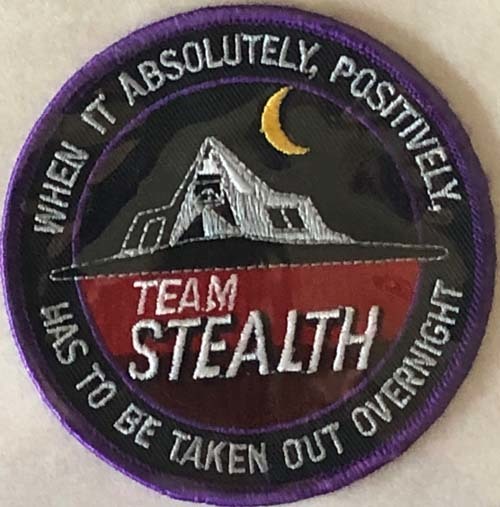
Within a week, the F-117s began executing flights under the cover of night. The F-117 is an American single-seat, twin-engine stealth attack airplane developed by Lockheed’s Skunk Works division. It was the first aircraft to be designed around stealth technology, and initially became operational in 1983. The Air Force denied the aircraft even existed until November 10, 1988, when a grainy photograph of the F-117 was displayed during a Pentagon press conference. Of the 64 F-117s built, 59 were production versions. Its first mission was during the U.S. invasion of Panama in 1989. Although some F-117s still exist, the Air Force announced the retirement of the airplane in late 2006.
During the first few days at his new duty station, rumors were rampant that Iraq had chemical weapons, so Rene always had chemical gear at the ready. Thankfully, it was soon determined that chemical weapons from Iraq did not have the range to reach where Rene’s unit was located, although the hangars at King Khalid Air Base were designed to survive chemical attacks. “The facilities where we worked were extremely secure and even more modern and much more expensive than the F-117 hangars back at Tonopah,” he jokes. “The Saudis spared no expense.”
Despite his arrival in Saudi Arabia during the hottest part of summer, Rene says the weather in Khamis Mushait was similar to Tonopah, because both locations are at approximately 7,000 ft. elevation. Fortunately, all the buildings, including his residence, were air conditioned. Since he was raised in the city and is not a fan of snakes, he was glad he only saw one King Cobra while deployed, on the road in front of him while he was driving on the compound. The snake was so long it stretched across the entire width of the road, its head upright in classic striking position. King Cobras are the world’s longest venomous snake and can reach 18 feet in length, so Rene says he took special care to drive far around the slithery creature.

For the first few months, Rene and his colleagues ate “mystery meat,” but then American food and care packages began to arrive from home. He appreciated all the snacks, toiletries, and gum, and began to record messages for his family on cassette tapes that he mailed back to New Hampshire. Initially, Rene and 14 of his enlisted colleagues stayed in a house on base, and since he was among the highest-ranking enlisted troops, he shared a bedroom with three other Tech Sergeants—two of whom he’s still in touch with. Once the second wave of troops arrived, a tent was attached to the house for an additional 10 troops. All of them shared the same four bathrooms, which was manageable only because they worked different shifts.
Since alcohol is banned in Saudi Arabia, Rene, who is a self-proclaimed beer snob, had to endure an eight-month dry spell. His workdays were long, and after work he exercised to help pass the time, ultimately dropping about 20 pounds. But sometimes he and his buddies broke out the O’Doul’s non-alcoholic malt beverages, donated for the troops by Anheuser-Busch, while they played cards and dominos before turning in for the night. Unlike real beer, Rene said he could only drink two or three O’Doul’s at a time because they had no flavor, although he admits a couple times he felt like he was buzzed from O’Doul’s and the monotony of deployment.
There was, however, one incident when a relative of someone in his unit mailed a rum cake for Christmas, which surprisingly made it through the incoming mail sensors. “Someone told me, ‘You need to try this cake!’” he says. “It tasted really good, but it was like taking a shot of rum. So then of course I devoured the entire piece and got a little tipsy. That piece of rum cake actually helped me get into the Christmas spirit and allowed me to forget where I was, if only for a little while.”
Next time: Precious letters from devoted American schoolchildren, Rene’s mother spearheads a patriotic movement back in Salem, and the build-up to the invasion.
Sentimentally,




